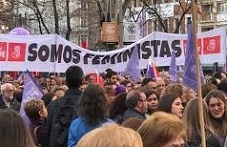 The etymological root of banner is found in two words of the Greek language : pân (which refers to a “whole” ) and chártēs (translatable as “paper” ). These ideas derived, in Low Latin, into pancharta , the closest antecedent of banner .
The etymological root of banner is found in two words of the Greek language : pân (which refers to a “whole” ) and chártēs (translatable as “paper” ). These ideas derived, in Low Latin, into pancharta , the closest antecedent of banner .
According to the first meaning mentioned by the Royal Spanish Academy ( RAE ) in its dictionary, a banner is a scroll that is formed by copying different documents. Currently, however, the most common use of the concept is linked to the poster displayed at a public event to transmit a message of protest or demand .
Banners, therefore, are proclamations that are displayed at demonstrations and marches, or that are displayed at certain events to draw attention to some type of problem. Many times they are constituted as a propaganda resource .
It is possible to make a banner with paper , cardboard , fabric or other materials. The important thing is not the material support or the chosen format, but the message they spread.
Suppose that several leftist organizations meet to protest against the armed intervention of a certain country in a foreign territory. The protesters gather in a square and carry different types of banners : in favor of peace, in repudiation of the nation that ordered the development of the war action or even to identify the political parties that promote the protest in question. Thus, the participants raise their banners so that everyone can read them and so that the expressions are transmitted through the images recorded by the media.
Unlike what happened until a few years ago, today it is possible to design a banner on the computer or any other device that is capable of running a graphic editing program, and then print it, either at home or in a center. that has devices for printing on canvas or large sheets.
 It is worth mentioning that the concept of a banner has evolved over the years and today it also serves to refer to a digital poster that is displayed over the Internet on a web page. In this case it is usually used with the aim of including advertisements or graphic links to other sites.
It is worth mentioning that the concept of a banner has evolved over the years and today it also serves to refer to a digital poster that is displayed over the Internet on a web page. In this case it is usually used with the aim of including advertisements or graphic links to other sites.
Just like banners that are made with the intention of being used in protests or public demonstrations, digital ones must also prioritize the clarity of the message over aesthetic aspects , and for this there are several tips that we can take into account to avoid poor results. First is the use of color . As tempting as it may be to include a wide range of shades in our project, in these cases we must always rely on the idea that "less is more."
The amount of colors should not be high for good results, but rather it should adequately reflect the theme as well as the text of the message. For example, if the banner is made for a demonstration about caring for the environment, the recommended color palette should include greens, browns, reds and blues, but not all but those that most clearly express the message: if the problem is related to water, we use blue; if you focus on the trees, green and brown.
Having decided on this aspect of the banner, it is time to think about the graphic elements that will accompany the text. This point is delicate, because it can force us to reduce the font size, with the consequence that the message becomes less readable. That is why it is recommended to complement it with the right amount of drawings , or do without them.
